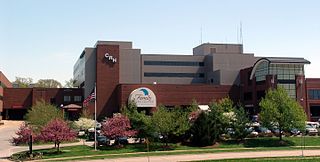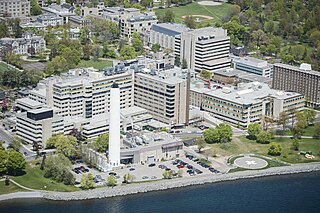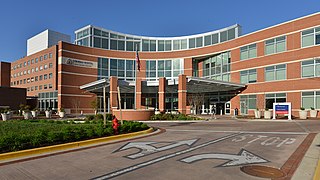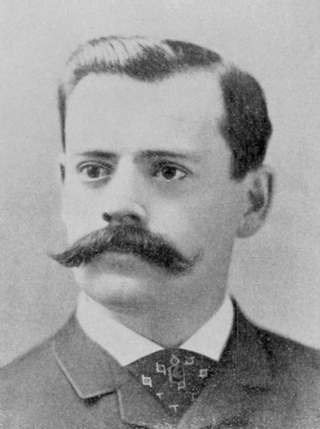Related Research Articles

An emergency department (ED), also known as an accident and emergency department (A&E), emergency room (ER), emergency ward (EW) or casualty department, is a medical treatment facility specializing in emergency medicine, the acute care of patients who present without prior appointment; either by their own means or by that of an ambulance. The emergency department is usually found in a hospital or other primary care center.
Katherine Shaw Bethea Hospital is a hospital in Dixon, Illinois. KSB Hospital is an 80-bed acute care facility providing comprehensive ancillary services, including emergency medicine, obstetrics, inpatient psychiatry, a cardiovascular laboratory, outpatient surgery, inpatient surgery, and intensive care, among others.

R Adams Cowley Shock Trauma Center is a free-standing trauma hospital in Baltimore, Maryland and is part of the University of Maryland Medical Center. It was the first facility in the world to treat shock. Shock Trauma was founded by R Adams Cowley, considered the father and major innovator of trauma medicine.

Emergency medical services in France are provided by a mix of organizations under public health control. The central organizations that provide these services are known as a SAMU, which stands for Service d’aide médicale urgente. Local SAMU organisations operate the control rooms that answer emergency calls and dispatch medical responders. They also operate the SMUR, which refers to the ambulances and response vehicles that provide advanced medical care. Other ambulances and response vehicles are provided by the fire services and private ambulance services.

Sabbatsberg Hospital is a former hospital in central Stockholm, Sweden. Its located on Sabbatsberg, situated between Torsgatan, Vasaparken, Tegnérgatan by Barnhusbron, and Dalagatan in Vasastan. It was opened in 1879.

University of Missouri Health Care is an American academic health system located in Columbia, Missouri. It's owned by the University of Missouri System. University of Missouri Health System includes five hospitals: University Hospital, Ellis Fischel Cancer Center, Missouri Orthopedic Institute and University of Missouri Women's and Children's Hospital — all of which are located in Columbia. It's affiliated with Capital Region Medical Center in Jefferson City, Missouri. It also includes more than 60 primary and specialty-care clinics and the University Physicians medical group.

The University of Missouri Women's Hospital, formerly University of Missouri Women's Hospital, is the only hospital in Missouri exclusively dedicated to the health of women. The hospital was formerly home to MU Children's Hospital, and is currently home to MU Women's Center, and the Family Birth Center. The Women's Hospital no longer has a pediatric Emergency Room and inpatient services, having moved to University Hospital. In Fiscal Year 2009, 1,793 babies were born in the Family Birth Center. The hospital has the da Vinci minimally invasive surgical robotic system. It is located in eastern Columbia near the interchange of Interstate 70 and U.S. 63 at 404 North Keene Street.
Spartanburg Regional Healthcare System(SRHS) is one of South Carolina's largest healthcare systems. SRHS draws patients primarily from the areas of Spartanburg, Cherokee, Union, and Greenville counties (all located in the Piedmont region of South Carolina), as well as Polk county (located in western North Carolina). Spartanburg General Hospital was organized under the authority of the South Carolina General Assembly in 1917. It officially became the Spartanburg Regional Health Services District, Inc., a political subdivision of the State of South Carolina, by the charter granted by the Secretary of State of South Carolina on May 1, 1995.
St. Cloud Hospital is a hospital in St. Cloud, Minnesota, United States. It is a Catholic-affiliated, not-for-profit institution and part of CentraCare Health. The hospital has more than 9,000 employees, 400 physicians and 1,200 volunteers. It serves 690,000 people in a 12-county area.

Baptist Health (Jacksonville) is a faith-based, non-profit health system comprising 6 hospitals with 1,168 beds, a cancer center, four satellite emergency departments and more than 200 patient access points of care, including 50 primary care offices located throughout northeast Florida and southeast Georgia. The headquarter is in Jacksonville, Florida.

The Kingston General Hospital (KGH) site is an acute-care teaching hospital affiliated with Queen's University located in Kingston, Ontario, Canada. Along with the Hotel Dieu Hospital (HDH) site, these hospitals form Kingston Health Sciences Centre which delivers health care services to more than 500,000 residents throughout southeastern Ontario; conducts health care research and trains future health care professionals.

MelroseWakefield Hospital is a 174-bed non-profit hospital located in Melrose, Massachusetts. MelroseWakefield Hospital and Lawrence Memorial Hospital of Medford function as one hospital entity with two campus locations. The MelroseWakefield Hospital campus provides many different areas of inpatient patient care including general surgery, interventional cardiovascular services, gynecology, maternity, special care nursery, orthopedics, and urology. It also offers outpatient care such as same day surgery, endoscopy, imaging and emergency services as well as serving as the region's Level III Trauma Center.

Newton-Wellesley Hospital (NWH) is a community teaching medical center located in Newton, Massachusetts on Washington Street. It is affiliated with Tufts University School of Medicine and Harvard Medical School. Founded in 1881, part of its campus is listed on the National Register of Historic Places as the Newton Cottage Hospital Historic District.

Adventist Health Portland, is a 302-bed hospital serving 900,000 residents on the east side of the Portland-Vancouver metropolitan area in the United States. It is the primary teaching hospital of the Walla Walla University Nursing program.
Premier Health Miami Valley Hospital South is a hospital in Centerville, Ohio. It is a branch of Miami Valley Hospital in Dayton, Ohio and is managed by Premier Health. Designed and constructed in 2007 as an outpatient facility with an emergency department, the facility grew faster than expected and became a full-service hospital with as office building for physicians and a five-story patient wing added between 2009 and 2013. As of 2013, the hospital is a 579,000-square-foot (53,800 m2) complex on a 115-acre (47 ha) campus adjacent to Interstate 675. It has 60 beds and features a number of specialty care options including oncology, cardiology, sports medicine, and maternity care to cater to the suburban community surrounding the hospital.

Our Lady of Bellefonte Hospital was a 214-bed not-for-profit acute care hospital located in Russell, Kentucky in the Tri-State region of Northeast Kentucky, Southern Ohio, and Western West Virginia. Part of the Catholic-based Bon Secours Kentucky Health System, Inc., Our Lady of Bellefonte Hospital employed approximately 1,200 healthcare professionals, making the hospital the largest employer in Greenup County.

Suburban Hospital is a community-based, not-for-profit hospital serving Montgomery County, Maryland, and the surrounding area since 1943. Located in Bethesda, Maryland, Suburban is the designated trauma center for Montgomery County. Suburban Hospital is affiliated with many local health-care organizations, including the National Institutes of Health. The hospital specializes in surgery, orthopedics, cardiology, neurology, oncology, emergency/trauma and a variety of additional clinical services. On June 30, 2009, Suburban Hospital became a member of Johns Hopkins Medicine.
VIP medicine is a variety of the VIP syndrome—the phenomenon of a perceived "VIP" using his or her status to influence a given professional or institution to make unorthodox decisions under the pressure or presence of said VIP—that relates to the accessibility and quality of health care. It is essentially health care in which a physician or hospital accommodates a wealthy, important or famous patient who can afford to pay the full medical bill outright, usually with luxury amenities, and seclusion from the ordinary run of patient, as added benefits. As a result, such a patient may receive something other than the normal standard of care; the deviation may be in the direction of either greater or lesser safety and quality.

George William Galvin was an American physician who was the founder of the Boston Emergency Hospital, the first emergency hospital in the United States.

William Allen Brooks Jr. was an American surgeon, college football player, coach, referee, and rower. He played football and participated in rowing at Harvard and afterwards was a prominent surgeon as well as official, additionally serving one year as the Harvard football coach.
References
- 1 2 "Grace Hospital, New Name". Boston Evening Transcript. November 7, 1908. Retrieved June 26, 2024.
- 1 2 "All Don't Agree". The Boston Daily Globe. June 22, 1901. p. 8. Archived from the original on March 4, 2023. Retrieved March 4, 2023– via Newspapers.com.
- 1 2 3 4 Trickey, Henry G. (July 3, 1891). "Speedy Aid To Injured". The Boston Daily Globe.
- 1 2 3 4 "Proof That It Was Greatly Needed". Boston Evening Transcript. July 16, 1891. Retrieved June 26, 2024.
- 1 2 "Established 14 Years". The Boston Daily Globe. March 11, 1906.
- ↑ "Have Changed Their Minds". The Boston Daily Globe. March 28, 1896.
- 1 2 "Letters to the Editor". The Boston Daily Globe. December 3, 1904. Retrieved June 28, 2019.
- ↑ "Dr. George Galvin Has Passed Away". The Boston Daily Globe. August 17, 1928.
- ↑ "Dr. Galvin's Decision". The Boston Daily Globe. February 7, 1903.
- 1 2 3 "Enlarged and Improved: Boston Emergency Hospital on Kingston St Has Remodeled Building and Three New Departments". The Boston Daily Globe. September 19, 1904.
- ↑ "No Money For Emergency Hospital". Boston Evening Transcript. March 17, 1896. Retrieved June 26, 2024.
- ↑ "Emergency Hospital Reopens". The Boston Daily Globe. September 20, 1899.
- 1 2 3 "With New Features: Emergency and General Hospital Opened". The Boston Daily Globe. November 10, 1904.
- ↑ "Leaves Emergency". The Boston Daily Globe. March 11, 1906.
- ↑ "Takes Grace Hospital". The Boston Daily Globe. July 1, 1911.
- ↑ "Tufts College Now In Charge". The Boston Daily Globe. March 11, 1906.
- ↑ "Grace Hospital Decision". The Boston Daily Globe. September 14, 1912.
- ↑ "Boston". The Reference Register. New York: Phillips' Directories Company. 1918. Retrieved June 29, 2019.